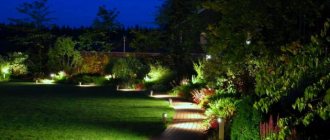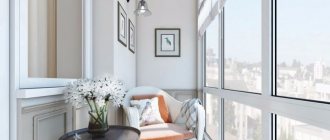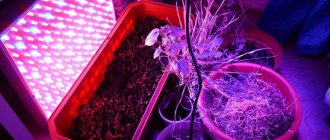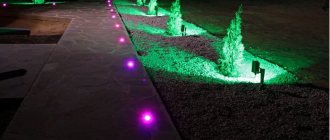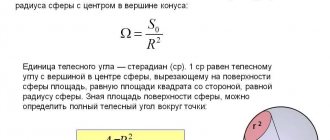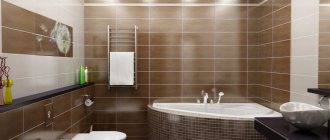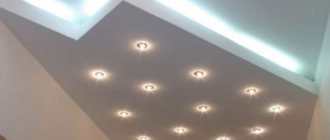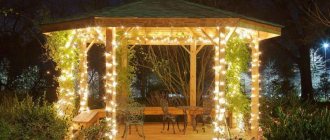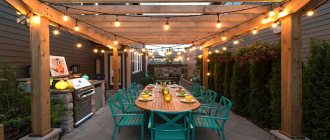Artificial lighting is provided using various types of light sources. Artificial lighting at industrial, civil facilities and construction sites, according to its functional purpose, is divided into work , duty, emergency , evacuation , and security .
Working lighting must be provided for various buildings, structures, areas of spaces intended for work, traffic and the passage of people. Working lighting can be general, local and combined (local lighting is added to general lighting).
General lighting is designed to illuminate the entire room. General work lighting, depending on the type of work, can be uniform or localized. When designing general lighting in the workplace area, the ratio of maximum to minimum illumination should not exceed 1.5 for work of categories I – III with fluorescent lamps; with other light sources – 2; for work of categories V – VII – 1.8 and 3, respectively.
Local lighting is intended to illuminate only the working surface; it can be stationary or portable. It is prohibited to use only local lighting, because it creates rapid fatigue due to uneven lighting.
Combined lighting is used to create sufficiently high levels of illumination on work surfaces through the simultaneous use of general and local lighting systems.
Emergency lighting is provided in buildings and places of work if turning off the working lighting will lead to disruption of work technology, maintenance of machines and mechanisms, operating hours of children's medical institutions, explosions, fires, injuries, poisoning of people, etc. In emergency lighting mode, the minimum illumination of the working surfaces of enterprise areas requiring maintenance must be at least 5% of the standardized working lighting, but not less than 2 lux inside buildings and not less than 1 lux for the territory of enterprises.
Evacuation lighting in premises or in places of work is provided if there can be 100 or more people in the room at the same time, if in production premises where during the period of switching off the working lighting, people may be injured, along the main passages, staircases of production premises, with the number of evacuees more than 50 people, in the stairwells of residential buildings with a height of 6 floors or more. Evacuation lighting must provide at least 0.5 lux on the floor or ground in the premises; in open areas - 0.2 lux.
Security lighting should be provided along the boundaries of the territory protected at night. Illumination should be 0.5 lux at ground level in a horizontal plane or at a level of 0.5 m from the ground.
Lighting with open lamps is harmful because... it does not protect against the blinding brightness of the incandescent lamp filament; it scatters the flux in all directions. Therefore, special fittings are used together with the lamp. All together is called a lamp.
Lamps are divided according to purpose into internal, external and special. According to light distribution, luminaires are divided into:
1. Direct light luminaires that provide luminous flux downwards, onto the walls and onto the floor (“Alpha”, “Beta”, “Universal”, “Deep Emitter”);
2. Reflective light fixtures that send a luminous flux to the ceiling, reflecting from which they illuminate the room;
3. Ambient light fixtures “Lucetta” (LC), “Milk Ball”, etc. (Fig. 2.4.7)
For different premises, depending on the production technology, certain types of lamps are selected and regulated. For example, in dusty rooms, lamps of type A, Um, Up, RN, etc. can be used.
The choice of luminaires should be made taking into account the following factors:
a) safety, durability and stability of lighting characteristics in a given environment;
b) energy efficiency;
c) lighting quality;
d) ease of service;
d) appearance and cost.
Basically, incandescent lamps and gas-discharge lamps are used as artificial lighting.
Incandescent lamps : a – “Universal” (U, UM); b – enameled deep emitter (GE); c – mirror deep emitter (MS); g – oblique light; d – lancet with solid glass (NSP-07); e – frosted glass ball (PO-02); g – export-protective sealed (VZG); h – industrial compacted (PU); and – direct light “Alpha”.
Incandescent lamps are thermal light sources; they are characterized by low cost, simplicity of design, and ease of use. Disadvantages include high brightness (dazzle), low luminous efficiency (7 - 20 lm/W), short service life (up to 2.5 thousand hours), high heating temperature (140°C and above), fire hazard, unnatural lighting (yellow-red radiation), inapplicability during vibration-impact operation of mechanisms.
Incandescent lamps are used mainly for indoor lighting and local lighting for temporary work.
Gas-discharge lamps , as a result of luminescence due to electrical discharges in inert gases and metal vapors, emit light in the optical range.
They are economical (service life up to 10 thousand hours), heating temperature up to 60 ° C, high luminous efficiency (90 - 100 lm/W), luminous flux can be emitted in a different spectrum by selecting a phosphor and inert gas vapors
Main disadvantages: pulsation of light flux, complex switching circuit, noise when switched on, relatively high cost.
When using gas-discharge light sources in lighting installations, one of the main indicators of lighting quality is the permissible level of pulsation of the light flux. The pulsation depth is usually assessed by the illumination pulsation coefficient Kn (%). This coefficient is a criterion for assessing the relative depth of illumination fluctuations as a result of changes in time of the luminous flux of gas-discharge lamps when powered by alternating current.
(2.4.10)
where Еmax, Emin – respectively the maximum and minimum values of illumination during the period of its fluctuation, [lx.];
Eсr – average illumination value for the same period, [lx].
Today, fluorescent gas-discharge lamps are produced, which differ in their emission spectrum. These are fluorescent lamps (LD), fluorescent lamps with improved color rendering (LDC), type LE - close in spectrum to natural sunlight, LB - white lamps (with low emission of blue-violet rays). Cold-white light lamps LHB, LHE have better light transmission than LB and LD lamps, warm-white light lamps LTB (light pink-white tint).
Gas discharge lamps come in low and high pressure. Low-pressure lamps are called fluorescent lamps and are used in everyday life and in production.
High-pressure gas-discharge lamps are used in conditions where high luminous efficiency and durability under environmental conditions are required: metallogenic (MGL), mercury arc (MAA), sodium (DNaT).
In addition, special purpose lamps are produced (bactericidal, etc.).
According to the degree of protection of the lamp from environmental influences, they are divided into dust-proof (open), dust-proof and dust-proof, moisture-proof, waterproof or hermetically sealed, and explosion- and fireproof.
The main characteristics of artificial lighting sources are: electrical power of the lamp, [W]; luminous flux, [lm]; luminous efficiency, [lm/W]; supply voltage, [V]; service life, [thousands hours]; spectral composition of light; cost, etc.
Lighting characteristics of luminaires include efficiency, luminous intensity curves, protective angle, light distribution, etc.
In table 2.4.4 and 2.4.5 show the values of standard illumination in the workplace depending on the size of visual work, the size of objects (background, contrast).
The degree of eye protection from direct rays of light is determined by the protective angle , which is formed by a horizontal line passing through the center of the luminous body and a boundary line connecting the extreme point of the luminous body and the fire edge of the reflector. Within the protective angle, the lamp is completely hidden from the eyes of the operator by the edge of the fittings.
(2.4.11)
where hc is the vertical distance from the lamp filament to the edge of the fittings;
R – horizontal distance from the edge of the reinforcement to the center of the filament;
r is the horizontal distance from the center of the filament to its edge.
Fig.2.4.8. Methods for calculating artificial lighting
The distance between the lamps or their most advantageous location λ is determined by the ratio (Fig. 2.4.8):
(2.4.12)
where L is the distance between the lamps;
h – height of the lamp suspension.
From here:
(2.4.13)
The most advantageous location of luminaires λ, taking into account light distribution, can be determined from tables in reference books. In practice, the distance between lamps is taken to be L = 1.5...2h.
When designing artificial lighting, three methods are used: point method, method of using luminous flux and method of calculation based on specific power (Fig. 2.4.8).
Let's consider an example of using the method of using luminous flux F, which takes into account the luminous flux reflected from the light source, walls, ceiling, and equipment elements.
Table 2.4.4
Normalized lighting on work surfaces under artificial lighting according to visual parameters (gas discharge lamps)
| Visual work | Smallest size of difference object, mm | Visual work category | Visual work subcategory | Contrast of the object of difference with the background | Background characteristics | Illumination, lux |
| with combined lighting | in general lighting | |||||
| Highest accuracy | less than 0.15 | b | small medium | medium dark | ||
| V | small medium large | light medium dark | ||||
| G | medium large large | light light medium | ||||
| Very high accuracy | from 0.15 to 0.3 | II | A | small | dark | |
| b | small medium | medium dark | ||||
| V | small medium large | light medium dark | ||||
| G | medium large large | light light medium | ||||
| High accuracy | above 0.3 to 0.5 | III | A | small | dark | |
| b | small medium | medium dark | ||||
| V | small medium medium | light medium dark | ||||
| G | medium large large | light light medium | ||||
| Average accuracy | above 0.5 to 1.0 | IV | A | small | dark | |
| b | small medium | medium dark | ||||
| V | small medium large | light medium dark | ||||
| G | medium large large | light light medium | ||||
| Low accuracy | above 1.0 to 5.0 | V | A | small | dark | |
| b | small medium | medium dark | ||||
| V | small medium large | light medium dark | ||||
| G | medium large large | light light medium | ||||
| Rough (very low precision) | more than 0.5 | VI | Regardless of the characteristics of the background and the contrast of the object with the background | |||
| Working with materials that glow and products in hot shops | more than 0.5 | VII | Regardless of the characteristics of the background and the contrast of the object with the background | |||
| General monitoring of the production process: when people are periodically in the room | VIII | a B C | Regardless of the characteristics of the background and the contrast of the object with the background |
Table 2.4.5.
Standardized illumination at workplaces of auxiliary buildings and premises
| Room | Artificial lighting Norm, lux | Natural lighting KEO (enIII), % |
| with overhead or combined lighting | With side lighting | |
| in an area with persistent snow cover | in the rest of the CIS | |
| Design halls and rooms, design bureaus | 1,6 | |
| Typewriting and machine counting bureaus | 1,2 | 1,5 |
| Reading rooms, offices | 0,8 | |
| Model carpentry and repair shops | 1,2 | 1,4 |
| Conference rooms, meeting rooms | 0,4 | 0,5 |
| Analytical laboratories | 1,2 | 1,5 |
| Weight | 1,2 | 1,5 |
| Washing | 0,4 | 0,5 |
| Washbasins; toilets; smoking rooms; showers; dressing rooms; rooms for drying, dust removal, decontamination of clothes and shoes, and for heating workers. | 0,2 | 0,3 |
| Doctors' offices, dressing room | 0,8 | |
| Treatment rooms | 0,4 | 0,5 |
| Premises for women's personal hygiene | 0,2 | 0,3 |
| Lobbies and street clothing closets | 0,3 | 0,4 |
| Main staircases | 0,2 | 0,2 |
| Other staircases | 0,1 | 0,1 |
| Main corridors and passages | 0,1 | 0,1 |
| Other corridors and passages | 0,1 | 0,1 |
| Machine rooms for elevators and rooms for freon installations | 30* |
* - standard for incandescent lamps
It is necessary to determine the location and number of lamps, taking into account the power of incandescent lamps in a room with a length of A = 10 m
, width
H = 6 m
, height
H = W m.
Reflection coefficients of walls qc and ceiling qp 70%.
According to SNiP II-4-79, taking into account the nature of visual work, we accept normal illumination as 200 lux; safety factor rз=1.3
(SNiP ΙΙ-4-79, Table 3), ratio of average illumination to minimum illumination
z=1.1
.
Coefficient depending on the type of lamp, a=1.5
.
Workplace height hc =0.8 m
;
distance from the ceiling to the lower edge of the lamp hc=0.6 m
.
We estimate the estimated height of the lamp suspension:
(2.4.14)
Finding the room index i
:
(2.4.15)
Distance between lamps:
(2.5.15)
The distance from the wall to the lamp is assumed to be l=0.8 m
.
Taking into account the luminous flux coefficient (the ratio of the flux incident on the design surface to the total flux of all lamps η=0.57
), we calculate the luminous flux with the number of lamps
N=8
.
(2.4.16)
Based on F
select the type and power of lamps.
When calculating localized lighting, the point method is usually used, for which it is necessary to know that µ
– coefficient of influence of remote sources of reflected light and
e
– conditional illumination, [lux].
Initially, e
is determined from spatial isolux graphs depending on the type of lamp located at a distance of 1 m and having a lamp luminous flux of 1000 lm.
The value of e
at the control point can be measured.
Lighting requires systematic care, proper operation of the lighting installation and control of lighting in the workplace at least once a year.
Depending on the specifics of the workshops, schedules are developed for checking the condition of window glass, lamps, electrical fittings, their cleaning and washing. Due to prolonged use of lamps, their luminous flux is reduced by up to 25%. Such lamps must be replaced promptly. It is prohibited to install luminaires that include different types of gas-discharge lamps, as well as those that have a different spectrum and luminous flux.
Cleaning of lamps should be carried out at least once every three months. Cleaning of window glass and light openings is carried out at least twice a year for rooms with a slight emission of dust, and at least four times with a significant emission of dust.
The main device for monitoring and measuring illumination on | workplaces have lux meters of types Yu-16, Yu-17, Yu-116, Yu-117. They differ in measurement boundaries and design. The principle of operation of all is the same and is based on the phenomenon of the photoelectric effect.
For automatic lighting control, PD photodiodes are installed at workplaces, which indicate insufficient illumination
Types of artificial lighting. Classification
The main types of artificial lighting, distinguished by the location and purpose of the light sources:
1) General. In any type of premises (residential, office, industrial) this type of lighting requires the presence of lamps in the upper zone or on the ceiling. When organizing the overall appearance, the light should be evenly distributed throughout the entire area of the room. For a small living room, this could be a chandelier or ceiling lamp. An office or industrial space typically uses a lighting system.
2) Local. This type of lighting is designed to highlight certain areas by placing light sources directly on a designated area of the room. For local lighting of housing, the following types of lamps are used: floor, wall, pendant, tabletop, built-in. In production or office premises, special lamps are used that direct light directly to the workplace.
3) Combined. Involves the simultaneous use of general and local types of artificial lighting. Effective for all types of premises: residential, office, public and industrial.
What can you experiment with?
With wire!
Pendant lamps with textile braided wires look impressive. This can be a twisted wire or a simple round braided wire. The number of color options is huge!
Exposed wiring can be an interesting design element. Attach it to the surface of the wall or ceiling with clips for open wiring; if the cable is twisted, use insulators.
It is important to know!
If you use a ceiling lamp or chandelier in the center of the kitchen as the main lighting, do not hang pendant lamps above the dining room! They will "argue" with each other. The best solution would be sconces.
If the main lighting is spotlights, pendant lights above the dining room would be a great option!
The main types of artificial lighting, distinguished by the direction of the luminous flux:
1) Directional or direct. Involves directing a light source towards a specific surface or object. As a result of directional lighting, an object is visually enlarged by emphasizing its volume and shape. In a living room, table lamps, spotlights, built-in lamps, floor lamps with shades, etc. are used for this.
2) Indirect. This type of artificial lighting is also called reflected, as it is obtained by directing the light flux to the ceiling or walls, from which it is reflected and illuminates the room. In a living room it can be implemented using lamps with a luminous flux directed upward or onto the walls. Reflected light visually increases the area of the room and is most effective in a bright interior.
3) Diffuse lighting is obtained as a result of the passage of light through a translucent or matte lampshade and is scattered throughout the room. One ceiling lamp with diffused light can illuminate a small room.
4) Mixed. It is obtained by combining the above types of artificial lighting. A lamp with mixed lighting can distribute the luminous flux in different directions and through a translucent shade or lampshade.
Labor safety standards and light in production and offices
Lighting in places where people engage in work must be strictly controlled in accordance with accepted standards. In Russia, SNiP 23-05-95 is most often used, as well as regional and industry standards. In Europe, EN12464-1 applies.
General tips for equipping your workspace with lighting fixtures
The quantity and quality of light must be appropriate to the task being performed by workers. The more complex and subtle it is, the more demands are made.
In the room where employees create drawings, the lighting level should be several times higher than in the reception areas where clients are consulted. Light coming through a window is often enough to observe technical processes.
A person’s perception of light flux is influenced by the flicker frequency, color temperature of the lamp, even its appearance. These factors should be taken into account whenever possible to ensure maximum employee productivity. Read more about the luminous flux of an LED lamp here.
Color temperature has a direct bearing on the psychological comfort of employees. Warm light promotes relaxation, but low color temperature sources are better in lounge areas and dining areas. Cold helps improve concentration and gives a feeling of alertness, which is good in places where precise work is done, but also increases the production of cortisol (Tommy Gouven) - the stress hormone, which can have negative consequences.
Safety standards must be followed.
High reliability of lighting sources will have a positive impact on overall productivity.
To avoid failures, purchase lamps only from trusted brands, among which Varton and DeLux are popular on the Russian market. They are assembled in accordance with accepted standards, have correctly selected and easily replaced components in case of breakdown.
Lighting systems should be easy to use.
It is good if the lamps are equipped with additional modules that allow you to adjust the direction, brightness and color of the flow. This will help workers in production independently adapt them according to their needs.
Characteristics of lighting systems
- Illumination - the amount of light, measured in Lux (lux), falling on a unit of working plane.
- Color temperature can be defined as the proportion between red and blue colors in the visible spectrum of radiation. Measured in K (Kelvins). The higher the value, the cooler the color.
- Color rendering index is the ability of a light source to convey the natural color of an object. Measured in Ra. The closer the score is to 100, the better.
- Flicker frequency is the frequency of periodic changes in the intensity of the visible radiation flux. Measured in Hz (Hertz).
- Illumination uniformity is a characteristic determined by the formula: d = Emin / Eav, where Emin is the minimum level of luminous flux on the measured surface unit, Eav is the average flux level on the surface unit.
- Glare index is a characteristic that determines the glare effect of a lighting installation (the ability to cause unpleasant sensations and reduce visibility due to its brightness).
- Power factor is a characteristic that determines how efficiently a system uses the energy it consumes to perform useful work. Low power factor values mean that losses are quite high, which is not only bad from an economical point of view, but can also lead to overheating of the system.
Standards
Light level
The more accurate the visual work performed, the higher the indicator should be.
Table - Comparative indicators of lighting brightness for work with different levels of visual load
| Visual accuracy | In combined type systems, taking into account the contrast of work objects with the background | In general systems | For work surface |
| Highest precision | From 5000 to 1250 Lux | From 1250 to 300 Lux | From 500 Lux to 400 Lux |
| Very high precision | From 4000 to 750 Lux | From 750 to 200 Lux | From 500 Lux to 400 Lux |
| Accurate | From 2000 to 400 Lux | From 500 to 200 Lux | From 300 Lux to 200 Lux |
| Medium accuracy | From 750 to 400 Lux | From 300 to 200 Lux | From 150 Lux to 100 Lux |
| Low accuracy | 400 Lux | 300 Lux | – |
| Low accuracy | – | 200 Lux | – |
| Using luminous materials | – | 200 Lux | – |
| * – Data taken in accordance with SNiP 23-05-95. For more detailed information, it is recommended to refer to the original source. | |||
Colorful temperature
Color temperature is also adjustable
various regulations.
When choosing a lamp, you should also focus on the feelings of employees, since their psychological comfort depends on this. A good solution is modern LED lamps, which allow you to adjust the color temperature using a dimmer for LED lamps. It can also be used to adjust the brightness of devices. Table - Comparative indicators of the required color temperature for different levels of visual load
| Visual accuracy | Color temperature, K |
| Working with colored materials, the need for very precise color discrimination | From 5000 to 6000 |
| Working with colored materials, the need for accurate color discrimination | From 3500 to 6000 |
| Working with colored materials, no need for precise color discrimination (for example, knitting, microcircuit assembly) | From 2700 to 6000 |
| Color difference doesn't matter much | From 2400 to 6000 |
| * The color temperature indicator depends on the strength of the luminous flux: the stronger it is, the higher the recommended range of the indicator. ** Data are given in accordance with SNiP 23-05-95. For more detailed information, it is recommended to refer to the original source. | |
Color rendering index
The choice of a lamp with a high or low color rendering index depends on how important this parameter is for the quality of work in production or in the office. Typically, systems with a CRI of about 50 Ra are sufficient in production facilities. For offices the value is about 60 Ra. LED lamps have high color rendering indices.
Flicker frequency
The well-being of workers greatly depends on the flickering frequency of lighting fixtures. It can cause various negative effects, ranging from a feeling of discomfort to fatigue, headaches and a feeling of visual strain.
A person notices flickering up to 100 Hz, flickering up to 300 Hz continues to influence his brain activity, and after this threshold the nervous system stops perceiving light pulsations (research by V.A. Ilyanok, V.G. Samsonova, “Lighting Engineering” No. 5, 1963) . Fluorescent lamps have a low flicker frequency, which negatively affects their perception by workers. LEDs have a safe frequency.
Fluorescent lamps should not be used in rooms where there are a lot of moving objects (machines, machines), since the frequency of their flickering in combination with the movements of the mechanisms helps create a stroboscopic effect, when objects seem stationary and moving in the opposite direction.
Blindness rate
Accurate data on the blindness rate for certain types of work can be found in various regulations. The more visual strain the work brings, the lower the value of the indicator is acceptable. The lower the contrast between the work object and the background, the higher the acceptable value for the indicator.
It is good if dimmable lamps are used for local lighting, so that the employee himself can adjust them in accordance with how he feels and the type of task being performed.
Illumination Uniformity
The general rule is this: the higher the accuracy of visual work, the more uniform the lighting should be.
When the light flux is uneven, visual tension increases several times. Uniformity is achieved through the correct combination of general and local systems and the correct distribution of lamps across the room area.
System type
The choice of the type of lighting system is determined by the work performed in the office or in production. If we are talking about household lighting, then you can easily use the characteristics given in the article for the correct organization of light in one or another part of the living space.
In accordance with SNiP 23-05-95, it is strongly recommended to use combined systems in rooms where work is carried out with high visual accuracy, medium visual accuracy (with low or medium contrast between the work object and the surface), low visual accuracy (with low contrast between the work object and background).
Comfortable light at home
Comfortable light in the office
More information about fluorescent lamps
Fluorescent lamps (hereinafter referred to as LL) differ in the spectra of radiation visible to the eye. Fluorescent lamps are close to natural light, so they are the least likely to tire your eyes. The disadvantage of this type of lamp is that their light is dominated by blue rays, which make human skin look unhealthy. White light lamps contain more yellow rays. Warm white lamps better convey pink and yellow colors, while cool white lamps emphasize the expressiveness of violet, cyan and dark blue.
LLs are sources of diffused and uniform light that does not produce a contrasting shadow. Their light output is such that, at the same power, it exceeds the similar light output of incandescent lamps. For this reason, they are economical, but under illumination conditions below 150 lux, a “twilight effect” occurs - in fact, the room is quite light, but it is not enough for the eye. If the choke is faulty, the LLs make noise or the light they emit begins to pulsate.
Incandescent lamps: pros and cons
Incandescent lamps (hereinafter referred to as incandescent lamps) have an emission spectrum with a large percentage of yellow and red colors. Purple and blue are in the minority. From the point of view of psychophysiology, their radiation is more pleasant, since it is warmer. In terms of impact on the psyche, LL clearly loses in this comparison. LN radiation is perceived by the eye as natural lighting, pleasant to the eye.
The disadvantages include extremely low energy efficiency.
Conclusion
As you can see, there are quite a lot of types of lighting and they all have certain requirements. In addition to the requirements we have given for the level of illumination, brightness and illumination coefficient, there are also requirements for the level of pulsation, color rendering, lighting difference, glare and many other parameters. Therefore, it would seem that such a simple task of choosing lighting can become truly problematic.
This is especially true for large industrial and commercial facilities. In this case, you cannot do without the help of professionals.
The role of reinforcement in artificial intelligence
Lighting fixtures successfully combat brightness by protecting against blinding direct rays. It is divided into three types:
- fittings for direct light (directs 90 percent of the flux of light rays onto a horizontal surface, used in kitchens, hallways, bathrooms);
- fittings for reflected light (the main part of the light flux is directed to the top of the wall and ceiling, reflected from them and evenly distributed);
- fittings for diffused-uniform light (some of the rays are reflected from the walls and ceiling and scattered throughout the room, passing through frosted glass).
IO standards for residential premises assume an illumination of 50 lux in the presence of incandescent lamps, the ideal is 200. At the same time, LL indicators in a residential area are exactly twice as high as LL.
Separation by purpose
Depending on the purpose, there are different types of electric lighting. The main ones are:
- Industrial buildings and facilities, as well as public spaces. These could be workshops and offices, as well as school classrooms or warehouses. The list is large and each type has its own standards and requirements.
- Private houses and apartments. Here, not only high-quality lighting of the rooms matters, but also interior design. There are no hard standards in residential areas, but there are recommended indicators.
- Street lighting. There are two options here - street lights in populated areas and local light sources in courtyards and private areas.
Street lights can also be decorative if used to illuminate the facade.
What you need to know about poor lighting
“Bad light” and “lack of light” are not always the same thing. Sometimes, when they say “bad light,” they mean flickering LL. And not everyone is aware that unevenness is far from the only characteristic of bad light. And that the worst is light that has a spectrum that is not comfortable for human vision. At the same time, its intensity does not play a role.
The optimal spectrum of light suitable for humans is the one emitted by the sun. The more similar an artificial source is to it, the better. The solar spectrum consists of different wavelengths, similar to the colors of the rainbow. In combination, they give a color called “white” according to the rules of lighting technology.
It must be taken into account that lamps have not only different power, but also color rendering and chromaticity, which are measured in units of Ra and K, respectively. LLs emit light that is closer to that of the sun than that of LNs. Each of the five phosphor bands has its own spectrum, resulting in a resemblance to the light of the sun.
To get the right lamp (and not just the most expensive one), you need to familiarize yourself with some important information. It’s reckless to just grab the least budget option and calm down. For example, specialized lamps for plants are very expensive, but they are absolutely not suitable for people.
How much light do you need to live correctly?
Lack of light not only spoils vision, but also causes fatigue. Ignorance of the basic basics regarding illumination creates inconvenience for us. The fact that our vision adapts and does not particularly feel the difference in lux, sometimes reaching a thousand units, often leads to a feeling of discomfort caused by something unknown.
A cleanly washed room is perceived as gloomy and dirty if you use a 25-watt LN. And at the same time, using a very bright LL in a dirty room, we will achieve the opposite effect.
Often in houses there are two- and three-arm chandeliers with 60–75 watts per bulb. Meanwhile, the need of the human eye is approximately 4 times higher. Many of us do not even suspect that we live in insufficient lighting, thereby harming our health.
There are official lighting standards specified in the lux for various rooms. But following them literally, firstly, is technically difficult, and secondly, it is not necessary - for several reasons:
- a difference of 100–200 lux is not perceivable by eye;
- the parameters are calculated for average vision without taking into account individuality;
- the standards are minimal due to the need to save energy.
Therefore, the norms should serve only as a guideline, and you should select an AI based on your personal needs, dividing the needs and taking into account the nuances - by trial and error. The main rule is that it is impossible to overdo it with light. This is especially true for people engaged in precision work that requires constant eye strain (jewelers, seamstresses, watchmakers). Even if you buy a lamp that is too bright in your opinion, you will not achieve a level of radiation equivalent in power to that of the sun.
Residential lighting standards
Lighting parameters for residential buildings and premises are standardized by the provisions of SP 52.13330.2011. Bright light is not always required, as shown by the table showing the current standards for indoor lighting:
| Illuminated objects | Average illumination, Lux (not less) |
| Children's | 200 Lx (on the floor) |
| Living rooms, kitchens | 150 Lx (on the floor) |
| Common areas, concierge room | 150 Lx (on the floor) |
| Corridors, bathrooms, restrooms | 50 Lx (on the floor) |
| Lobbies, floor corridors, staircase halls | 20-30 Lx (on the floor) |
How to determine the required amount of light yourself
The illumination of a particular location is related to several factors. This:
- how far away is the source;
- the power of light;
- reflectivity of the ceiling, floor and walls.
A uniform distribution of light sources is in most cases optimal for achieving the effect of maximum illumination.
The level of illumination is measured with a device called a lux meter.
With its help, a hygienic assessment of natural and artificial lighting is carried out, that is, its suitability for use is measured.
Important information
One of the immutable requirements for any type of artificial intelligence is safety: the presence of a grounding effect, insulation, and no access for children to a source of electricity.
The grounding effect is achieved through close contact of a conductive object with the soil. There are natural and artificial ground electrodes: the first are created by nature (trees), the second by man (lightning rod, rubber). In conditions of thunderstorms accompanied by lightning, artificial grounding has more than once saved people from electrical injuries.
AIs are indispensable for creating selfies, which have recently become a trendy trend. It is possible to create a high-quality selfie in natural light, but it is technically more difficult - you need to take into account where the sun is so that your face is not backlit, which is unacceptable for a selfie. AI allows you to control and adjust the level of illumination, so taking selfies in artificial light is much easier. This phenomenon is so popular in our time that it is possible that in the near future the hygienic requirements for artificial lighting will include suitability for high-quality selfies.
It is impossible to completely abandon natural light. But getting by with just one is also unrealistic for a modern person. Finding the optimal balance of natural and artificial lighting in the premises will create a comfortable environment at home, conducive to productive work, a mood at work and a favorable atmosphere for relaxation in places of entertainment.
Nuances
If you carefully read the text of the new sanitary rules, you can understand the following. Yes, the old rules SanPiN 2.2.1/2.1.1.1278-03 and SanPiN 2.2.1/2.1.1.1076-01 are no longer valid. But their main provisions, minus some abbreviations, were transferred to the text of the new SanPiN 1.2.3685-21 “Hygienic standards and requirements for ensuring the safety and (or) harmlessness of environmental factors to humans.” In fact, the new sanitary and epidemiological rules are a document that combines previously existing disparate sanitary standards relating to the safety of the living environment for the population. Standards for luminous flux have also become part of the new SanPiN and now there is no need to turn to other sources.
Comments Showing 0 of 0
